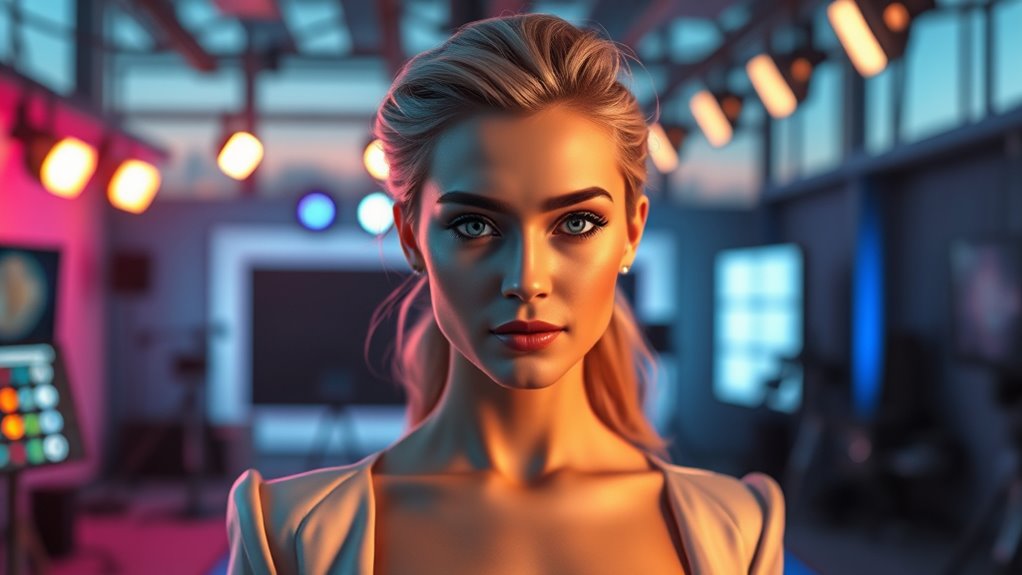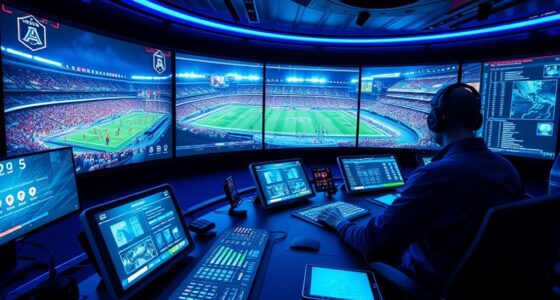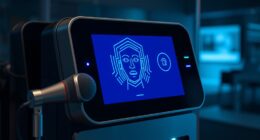Deepfake technology and AI-driven images are revolutionizing Hollywood by creating virtual actors that challenge traditional performances and raise ethical questions. This shift speeds up filmmaking, reduces costs, and offers new creative possibilities, but also sparks debates about authenticity, actor rights, and job security. As more studios adopt these tools, you’ll discover how industry leaders navigate these changes and what the future holds for AI in entertainment. Keep exploring to understand this evolving landscape.
Key Takeaways
- AI-generated actors, including deepfake technology, are increasingly used in Hollywood to create realistic digital performances.
- Industry adoption of AI tools accelerates film production efficiency, raising ethical concerns about authenticity and actor rights.
- Notable cases like Tilly Norwood highlight debates over transparency and the impact of deepfakes on acting careers.
- Deepfake technology blurs lines between real and synthetic performances, prompting calls for clear disclosure and ethical guidelines.
- The rise of AI actors threatens traditional jobs, emphasizing the need for policies balancing innovation with actor protection.
The Evolution of Virtual Actors in Film Production
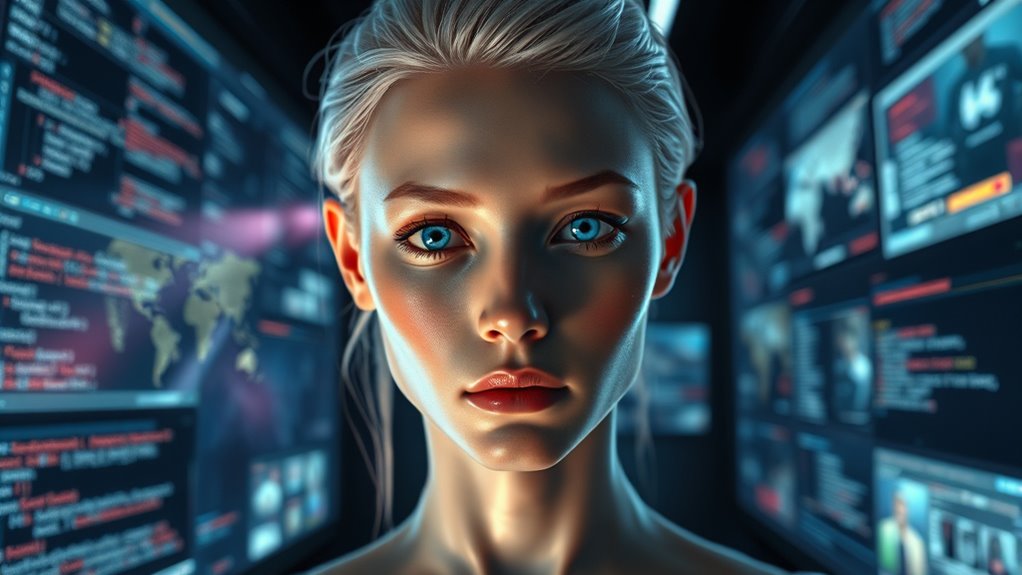
How have virtual actors evolved in film production over the years? You’ve seen how early CGI created simple, unrealistic characters. As technology advanced, virtual actors became more detailed and expressive, thanks to sophisticated machine learning and high-quality CGI. Now, AI-driven systems enable these digital personas to perform complex actions and convey a wide range of emotions, making them nearly indistinguishable from human actors. You can even merge AI with real actor likenesses to enhance biopics or craft entirely new digital stars. Additionally, ongoing advancements in digital character realism are pushing the boundaries of believability in virtual performances. Furthermore, the integration of remote collaboration tools allows global teams to work seamlessly on complex digital projects, accelerating innovation in virtual character creation. Automation tools streamline tasks like lighting, camera tracking, and continuity, reducing on-set workload. Post-production AI tools cut costs and speed up visual effects work, allowing filmmakers to experiment more creatively while maintaining efficiency. Moreover, the increasing use of real-time rendering techniques enables immediate visualization of digital characters, further enhancing creative workflows. Additionally, the increased use of financial planning and management in digital productions helps allocate resources more effectively, ensuring projects stay within budget and deadlines. This evolution is reshaping how stories are told and how roles are cast in modern cinema.
Industry Adoption and Market Growth of AI Technologies
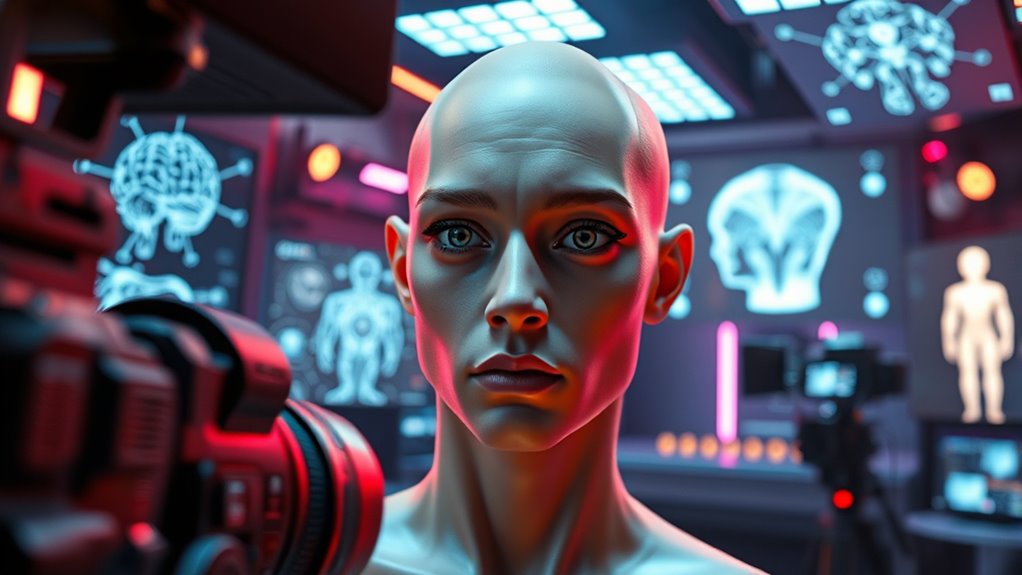
The adoption of AI technologies in Hollywood has accelerated rapidly, transforming every stage of film production. You’ll notice that over 70% of recent films incorporate AI tools, streamlining workflows and reducing costs. Since 2022, more than 65 AI-focused film studios have emerged, fueling industry growth. The global AI market for film is projected to hit $195.7 billion by 2033, highlighting its expanding influence. Despite this, major studios typically allocate less than 3% of their budgets to AI, reflecting cautious investment. AI systems automate tasks like lighting, camera tracking, and visual effects, making production safer and more efficient. The widespread adoption signals a fundamental shift, as AI becomes integral to creating, editing, and enhancing cinematic content. Additionally, the integration of home theatre projectors into production workflows is increasingly common, enabling immersive previews and virtual sets that elevate the filmmaking process. As AI-driven tools continue to evolve, their role in enhancing creative storytelling is expected to grow even further.
Notable Cases and Industry Reactions to AI Performances
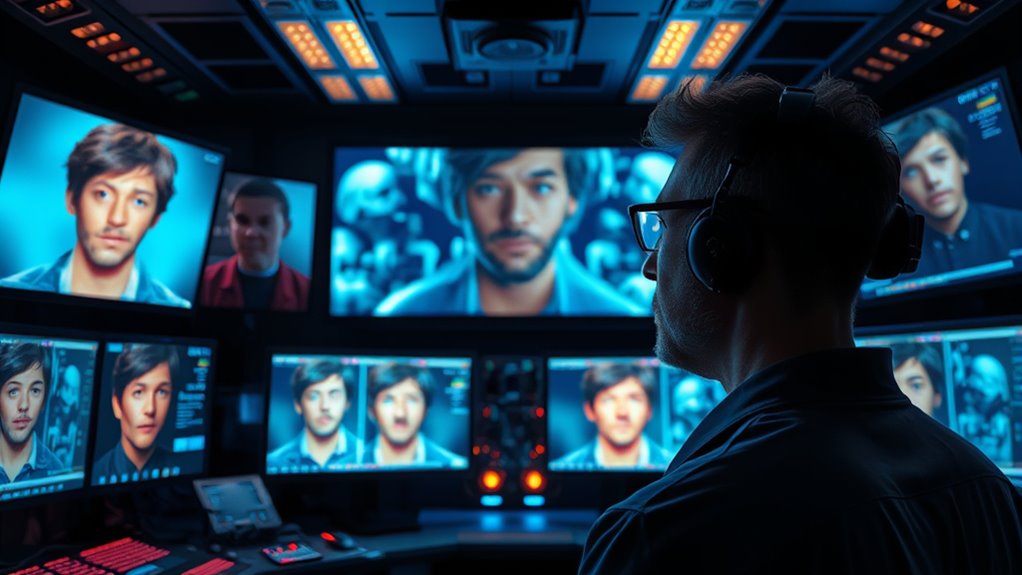
AI performances have sparked intense debate across Hollywood, especially after the debut of digital actor Tilly Norwood in October 2025. Her appearance prompted widespread criticism from unions and industry leaders, who argue that AI threatens traditional acting jobs. High-profile actors like Emily Blunt and Whoopi Goldberg voiced concerns about authenticity and artistic integrity, fearing AI could diminish human expression. Industry reactions ranged from cautious optimism to outright rejection, with SAG-AFTRA preparing to negotiate AI regulations to protect actors’ futures. Significantly, some filmmakers see AI as a tool to enhance storytelling, but ethical questions about deception and emotional authenticity remain unresolved. These cases highlight the tension between technological innovation and preserving the human element at the heart of acting. Additionally, discussions about the vibrational integrity of AI-generated performances are emerging, raising questions about their emotional authenticity compared to human actors. It is also important to consider how legal frameworks are evolving to regulate AI in entertainment. As the debate continues, the emotional authenticity of AI versus human performances remains a central concern for critics and audiences alike. Incorporating advanced analytics into AI tools might influence future perceptions of performance authenticity, further complicating the debate. Furthermore, understanding the dog names trend can shed light on how personal and cultural identities influence audience perceptions of digital actors.
Economic Impacts and Employment Challenges for Human Actors
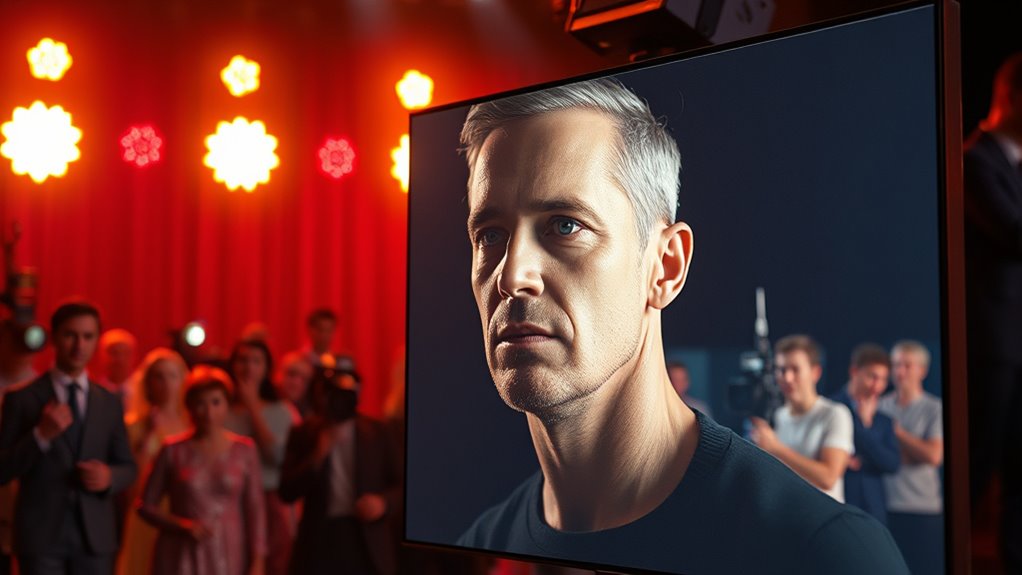
Despite advancements in virtual acting technology, human actors face significant economic challenges as automation and AI performances become more prevalent. The rise of AI actors threatens traditional jobs, as studios opt for cheaper, faster digital alternatives. This shift leads to high unemployment rates and income disparities among actors. During recent strikes, protections for SAG-AFTRA members improved, but many still struggle to find steady work. As AI continues to expand, your career stability feels increasingly uncertain. Additionally, the integration of AI-generated content may further accelerate industry changes, making it essential for performers to adapt to new technological landscapes.
Artistic Innovations and Creative Boundaries in Digital Acting

As virtual actors become more common in Hollywood, questions about their artistic potential and creative limits grow louder. You might wonder if AI-generated performances can truly evoke deep emotions or capture nuanced human experiences. While AI supports creativity by analyzing scripts and enhancing visual storytelling, it still relies on human input to shape meaningful narratives. Advances in machine learning enable digital actors to perform complex actions and express a range of emotions more convincingly, pushing the boundaries of visual realism. Additionally, the diminishing “uncanny valley” suggests digital actors are becoming more lifelike, but the challenge remains: can AI truly replicate the spontaneous, intuitive artistry that defines human performance? Moreover, material influence plays a role in how digital actors are designed and perceived, shaping the evolving landscape of digital artistry. This is further supported by automation’s role in business intelligence, which demonstrates how AI can analyze and interpret complex data to inform creative decisions. Furthermore, ongoing developments in anime technology demonstrate that digital characters are becoming increasingly sophisticated, influencing how audiences connect with AI-driven performances. The integration of breed traits in AI algorithms can help tailor digital characters to specific aesthetic and emotional profiles, enhancing personalization and audience engagement. As these technologies continue to evolve, the potential for digital actors to mirror human expression grows, opening new creative possibilities while raising ethical questions.
Future Directions and Ethical Considerations in AI-Driven Hollywood

The future of AI-driven Hollywood hinges on balancing technological innovation with ethical responsibility. As virtual actors become more realistic and prevalent, you must consider the implications for authenticity, transparency, and audience trust. Developers and studios need to establish clear guidelines for AI use, ensuring viewers are informed when they’re watching synthetic performances. Ethical concerns also include protecting actors’ rights, avoiding deception, and preventing job displacement. You should support policies that regulate AI’s role in storytelling, fostering a fair environment for human talent. Meanwhile, technological advancements will continue to push creative boundaries, but it’s vital that the industry prioritizes integrity and accountability. By addressing these issues proactively, you can help shape a future where AI enhances artistry without compromising ethical standards. Recognizing the importance of ethical guidelines can help ensure responsible deployment of AI in entertainment.
Frequently Asked Questions
How Do AI Actors Influence Traditional Acting Craft and Performance Authenticity?
AI actors influence the traditional acting craft by pushing you to adapt your skills and embrace new technologies. While AI can enhance storytelling with lifelike performances, it challenges your ability to convey genuine emotions and authenticity. You need to find ways to stand out and maintain your craft amid digital competition, emphasizing the human touch that AI still struggles to replicate fully. This evolution demands creativity and resilience from you as an actor.
What Legal Rights Do Ai-Generated Virtual Actors Hold Regarding Intellectual Property?
AI-generated virtual actors are like blank canvases, with their legal rights still undefined. Currently, they lack personal IP rights because they’re creations of software, not individuals. You should know that studios hold the rights to their digital likenesses, and laws are evolving fast. As AI advances, expect legal frameworks to clarify ownership, licensing, and attribution, shaping how these virtual actors are managed and protected in the industry.
Can AI Actors Develop Unique Personalities or Are They Entirely Script-Dependent?
AI actors can develop unique personalities, but they’re largely script-dependent. You program their behavior and emotional range based on data, so their personalities reflect the input and algorithms behind them. While advanced AI can mimic traits and adapt to roles, true originality is limited without human guidance. You might see some variation, but their core personality still relies on how you design and train their systems.
How Will AI Impact International Film Markets and Cultural Representation?
You’ll see AI profoundly impact international film markets by making productions more cost-effective and accessible worldwide. It enables the creation of culturally diverse virtual actors, broadening representation without the need for travel or local talent. However, you’ll also face challenges maintaining authentic cultural nuances. As AI adapts to different languages and traditions, you’ll need to navigate ethical considerations and guarantee that AI-driven content respects global diversity, fostering more inclusive storytelling.
What Measures Are in Place to Prevent Misuse or Deepfake Abuse in Cinema?
To prevent misuse and deepfake abuse, filmmakers and studios implement strict security standards, sophisticated software safeguards, and stringent legal limits. You should stay vigilant by supporting transparent practices and advocating for ethical AI use. Industry insiders are increasingly establishing clear codes of conduct, copyright protections, and contractual controls to curb deception. These measures aim to safeguard actors’ identities, ensure authenticity, and maintain trust in cinematic storytelling.
Conclusion
As AI-generated actors continue to expand, industry experts predict the market will reach $1.5 billion by 2025. This rapid growth highlights both exciting creative possibilities and significant challenges for human actors. While virtual performances release new artistic frontiers, they also raise ethical questions about authenticity and employment. Staying informed and adaptable will be key as Hollywood navigates this transformative era, balancing innovation with responsibility to shape a future where technology and artistry coexist.

